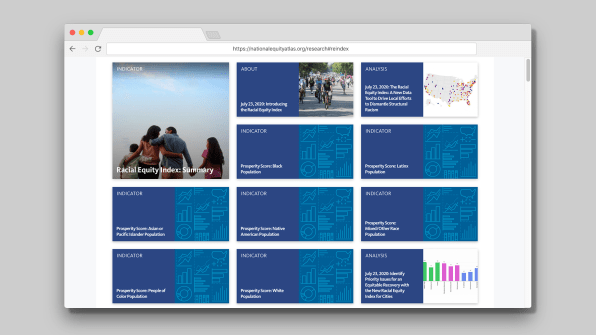Minneapolis-St. Paul, the center of the reigniting of the Black Lives Matter movement, has one of the highest rates of prosperity in the United States, ranked sixth among its 150 metropolitan-area peers. But it ranks 149th in terms of racial inclusion, indicating one of the worst racial wealth disparity gaps in the country.
This finding, and other granular details, have emerged as part of the Racial Equity Index, a new tool that allows users to view how 100 cities, 150 metro areas, and all 50 states, perform with respect to racial equity compared with their counterparts. Launched on July 23, it’s the latest iteration from the National Equity Atlas, “the nation’s most detailed report card on racial equity,” which provides evidence for the need to build “equitable, resilient, and prosperous” new economies. The hope is that this newest release of data can be harnessed by politicians to assess specific problems and craft policy that focuses more precisely on areas of need.
The new data resource takes the form of scorecards, accompanied by visually digestible analysis. The index’s nine specific indicators range from unemployment and median wage to air pollution, commute time, and rent burden (the share of renter-occupied households spending more than 30% of income on housing costs). Scores are generated, from 1 to 100, for each location’s performance and for each racial group within that location.
Using the tool, you’d discover that Minneapolis’s inclusion troubles stem from huge disparities in educational attainment. You’d see that, while 16% of white residents of the area are economically insecure, that rate is 57% for Black residents and 50% for Native Americans.

“Racial equity really is the defining issue of our time,” says Michael McAfee, president and CEO of Policy Link, which started building the atlas in 2014 along with USC’s Program for Environmental and Regional Equity. “We can’t tackle it without clear data on who is most impacted, where they live, and what are the most significant issues in their lives.”
For McAfee, the tool has rolled out at exactly the right moment, when protesters are still mobilizing across the nation. Data is crucial to concretely showing where the biggest prosperity gaps are, which racial groups they’re affecting, and what their causes are. “Now, we’re in a moment where we can merge our hopes and aspirations with the rigor of really good data,” he says.
“We live in a moment in which the world has broken open to try to pay attention to issues of racial inequity,” says Manuel Pastor, director of the USC program. “And I think it’s useful to have a tool on the shelf that can help you to do something about it.”
The index found that no community in America is free of racial inequities, even the highest performing, such as San Jose, California, in the middle of Silicon Valley. There, Black people have the highest college graduation rate yet still have an educational attainment rating that’s 23 percentage points lower than white people. It also found that some of the highest-scoring cities have low Black populations, such as Albuquerque, Reno, and Honolulu. Of the 33 bigger cities with the most Black residents, only two of them are in the top 20 for racial equity performance. Among the 25 best regions for prosperity, none are also in the top 25 for racial inclusion.
Pastor calls this a diagnostic tool, in that it shows where policymakers need to “move the needle,” and what groups need to benefit from policies and investments, all to reach the atlas’s ambitious end goal of dismantling structural racism on the local level.
McAfee says some localities have already made policy strides using the atlas’s prior data. It was used by Fairfax County, Virginia, to help establish One Fairfax, the county’s plan to advance racial equity and opportunity. It was used by Asheville, North Carolina, which last week announced its approval of monetary reparations for slavery and discrimination for Black residents.
While these examples give McAfee hope, he stresses that “data can never supplant conscious leadership.” Leaders need to be committed to acknowledging America’s racist past in order to make an effectual change. “The problem that this nation has faced is that it has not reconciled with the fact that its democracy and its economy were predicated on stolen land, genocide, and slave labor,” he says.
The COVID-19 crisis, he says, has exposed the cracks in a system that was “designed to be toxic for Black and brown people” and which is now affecting people on a wider scale. He mentions Florida’s failing unemployment system, which Republicans admitted was designed badly to purposely keep its users from receiving benefits. Now, it means people can’t receive their pandemic relief checks. “That is a real-world example of how anti-Black racism ends up impacting white America.”
When combined with the fighting spirit of this “rare moment,” where a diverse coalition of young people are demanding change, the data make McAfee optimistic for change—which needs to happen in an extensive and sweeping way in order to close up the gaps. “Black people can never catch up with white people unless you do something really radically transformative,” he says.
“Just as the founding fathers had the radical imagination to create something that was as beautiful as this democracy and this economy, but equally as oppressive for some,” he says, “we can remake it now.”
(32)